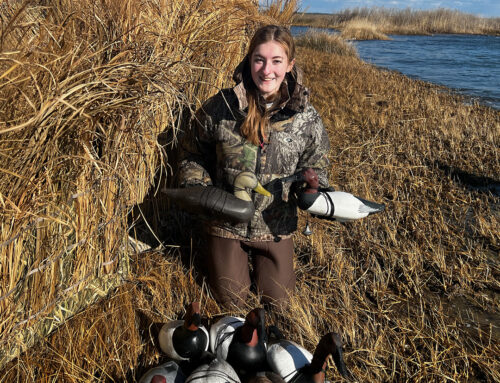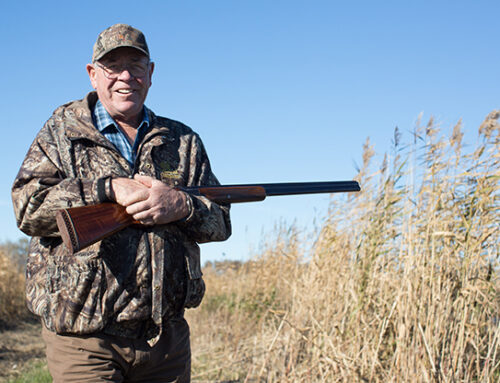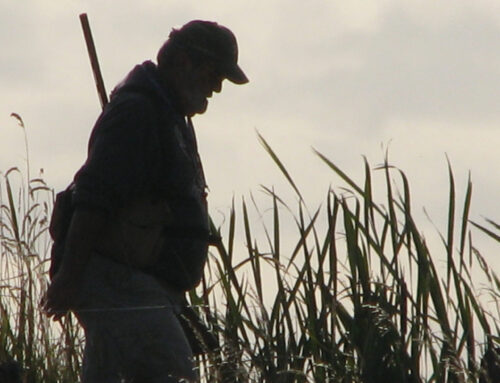In Defense of
Shooting Spoonies
Shooting Spoonies

Kyle Wintersteen, Managing Editor
The horizon was a sea of amber marsh grasses concealing a seemingly endless array of small wetlands. My first trip to North Dakota — indeed my first time hunting the Central Flyway — was a stark contrast to the creeks, rivers and lakes to which I was accustomed in Pennsylvania. And as the sun rose, the teal flew. We’d already laid into two flocks when a third gathered across the grassland, dipping and diving as a single unit en route to us.
But when the birds banked, offering a perfect angle for the morning’s gentle rays, their greenish-black heads and white breasts revealed that these weren’t teal at all. No, even better: I was about to get a crack at my first northern shoveler! I picked out a drake, attempted to subdue the “first duck” shake coursing through my fingertips and swung ahead of its black, oblong bill. My first drake spoon tumbled to the marsh.
“I’m going to mount that spoonbill!” I exclaimed like a child to my companions, my excitement overwhelming any sense of humility.
I was so elated when the taxidermy crate arrived at my tiny post-college apartment that I removed a photo of my mother in-law from the wall — what with the limited space and all — and hung it in the kitchen area. A curious place for taxidermy, but hey, the duck’s bill is, after all, a utensil.
I admired my shoveler every morning over breakfast, enjoying the memory of my big trip west. It was years later when I realized that my North Dakota friends had surely chuckled at my exhilaration. I had no idea that spoonbills carry an almost negative connotation in areas where they’re seen so frequently — where hunters pass on them lest ducks they consider more prestigious arrive later.
However, here in Pennsylvania, our duck straps typically consist of wood ducks, mallards, and black ducks, but I’ve yet to shoot a spoonbill in my home state. If a shoveler decoyed with a greenhead, I suspect many duck hunters would shoot the spoon and cherish it as a rare prize.
Yes, one man’s “trash duck” (a term I abhor as disrespectful, by the way) is another’s trophy. Thus, I argue, our system of ranking ducks based on prestige — which generally lists mallards, canvasbacks and pintails at the top and spoonbills somewhere just above coots — is merely a social construct.
Perhaps the shoveler needs a better public relations representative. If offered the job, my first order of business would be changing his name to the “spoon-billed teal,” in acknowledgment of its close relation to two prestige ducks: cinnamon and blue-winged teal. An ensuing advertising blitz would call attention to the fact everyone admires the lovely wings of the shoveler’s teal cousins, yet we ignore the spoonbill’s nearly identical green speculum and powder blue wing patches. Shovelers are also somewhat teal-like in flight, swift and challenging, if not less erratic.
Of course, there’s one final similarity between spoonbills and teal: If one crisscrosses my spread, I’m shooting.






Spoonies are always in duck hunter conversations. Some good, some bad. We shoot some, and on a few situations, we shot several. And on one occasion, shot several because nothing else was flying. But, if you could taste the jalapeño and duck breast poppers that my son makes, I would almost state that you can not taste a difference from mallard meat from spoonie meat. They are simply delicious and keep you going back for more. So, try and break that expensive duck club mentality and enjoy the “other duck” bounty. You might just be pleasantly surprised!
I was out spotting one evening in Central Oklahoma and had not seen a duck for several hours. On my last turn for home, out of the corner of my eye, I see a dozen ducks….”cupped up”, I muttered to myself in excitement. I hastily grabbed my binoculars, eager to see what these fast flying creatures were so keen to land on. As I adjusted my sights, I noticed these were no ordinary ducks….these were Northern Shovelers…and this was no ordinary pond. This was a center pivot, border town; the Deer Creek waste water treatment plant. There’s no questioning the splendor of a mature drake spoonbill and I concur with your assessment that these beautiful birds deserve a spot on the wall, but Kyle, those backdoor bandits have no right to be in anybody’s kitchen, and heaven forbid on anybody’s plate.
The great Northern Shoveler has saved many a slow day in the duck marsh for myself and my buddies. Put the meat in the grinder and I’ll challenge anyone to pick it out from the rest in a nice piece of duck jerky. It’s a great duck for kids to shoot their first birds on and as said before… on the slow days they give you something to do!
You are correct in stating the less re-known duck in one area may be a trophy in another. I’m in coastal La. and often covered up with beautiful Hooded Mergansers. However, I haven’t shot any in years. One is mounted, in its’ honor, but one is enough. I’ve hunted ducks over 50 years but never had a chance at a Canvasback nor a cinnamon teal or many other divers that many hunters see daily? All our waterfowl deserve our respect and any duck can be a trophy to a certain particular hunter.
“trash duck” (a term I abhor as disrespectful, by the way)
Amen, Kyle!
I love this article and your appreciation for the Northern Shoveler. If you have never been to Utah during the late December/early January timeline I invite you to please let me know when you would like to come out and we can kill full limits of Drake Shovelers. Some people pass on Spoonies, we get them so thick we only shoot good pure white breasted drakes and that hunt can take place in as fast as 30 minutes! Set up takes longer than a 5 man limit of beautiful drakes!
I’d love to share that with someone who appreciates the beauty of the Spoonie!
Regards,
Chris
Love the article and I personally love ducks all ducks. I actually love that Spoonies decoy so easy. Gives me confidence builder some days that the spread looks good!
My most beautiful and prized mount to date is a stud Spoonie. I’ve got 15 birds on the wall thus far. But that Spoonie….oh boy.